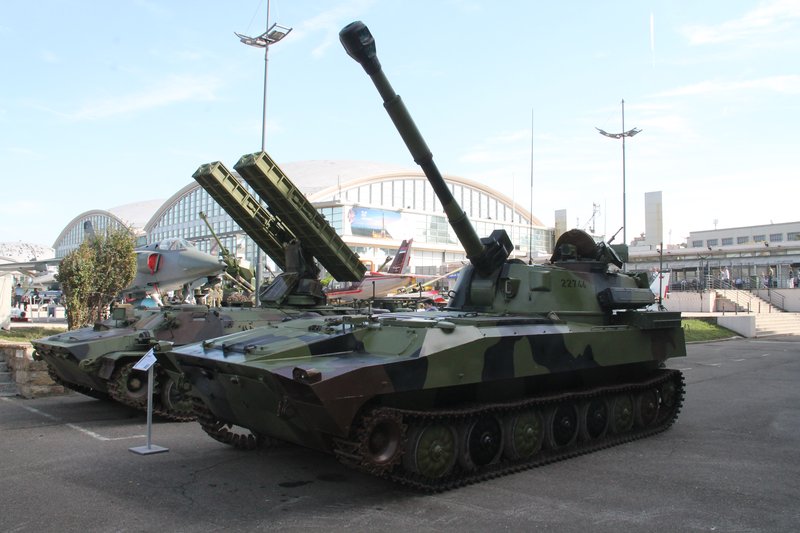Can Serbia find a market for upgraded Soviet artillery?
Over 10,000 122mm 2S1 Gvozdika self-propelled howitzers (SPH) were manufactured in the Kharkiv Tractor Plant in Ukraine by 1991, with additional vehicles built in Bulgaria and Poland. Large numbers of these remain in service with many countries today.
Serbian company Srboauto is now offering an upgrade to not only extend the Gvozdika’s life, but also enhance its firepower capability to 2S1 M21 standard, as already deployed by Serbia... Continues below
Newsletter Sponsors:

Above: This Soviet-era 122mm 2S1 SPH has been upgraded in Serbia to the latest M21 standard, retaining its amphibious capability. (Photo: author)
The existing 122mm 2A31 ordnance is retained but in addition to older Russian ammunition it can also fire two Serbian-developed projectiles, the TF M10 and TF M10GG, with the latter increasing its range to 21.5km.
A computerised fire control system (FCS) is fitted, coupled to an inertial navigation system (INS), which allows the upgraded howitzer not only to come into action much quicker but also carry out multiple round simultaneous impact (MRSI) fire missions.

The upgraded 2S1 can also make its own ballistic calculations, while the commander is provided with a 10in display and the gunner has an 8in screen.
The enhanced Gvozdika is fitted with a new heating, ventilation and air conditioning system for improved crew comfort.
The driver’s viewing system includes a front uncooled thermal imager for low visibility conditions and front and rear TV cameras for day use. The commander’s observation system meanwhile consists of a thermal imager with uncooled detector and a micro-display in the eyepiece.
For better survivability the upgraded 2S1 has a fully automatic fire detection and suppression system for engine and crew compartments, which can be activated manually if required.
The original SPH was not normally fitted with a roof-mounted machine gun (MG) for self-defence but the Serbian upgrade has a protected weapon station armed with the M86 7.62mm MG with the operator enjoying lateral protection through almost 360 degrees.
Other articles in this newsletter:
Why the mortar is enjoying a renaissance
Powering up: inside the new engine that could drive next-generation US Army combat vehicles
The upgraded version remains fully amphibious, being propelled in the water by its tracks at a maximum speed of 6km/h.
In addition to the SPH, Serbia has also developed an upgrade for Russian 1V13 series tracked mobile command posts, which are also referred to as Armoured Command and Reconnaissance Vehicles (ACRVs) in the West.
There are four basic versions of the Russian ACRV: 1V13 (deputy battery commander); 1V14 (battery commander); 1V15 (battalion commander) and 1V16 (deputy battalion commander).

In addition, the baseline ACRV is used for a wide range of other battlefield missions such as radar and electronic warfare.
The upgraded 1V13 and 1V16 are referred to as the M21v1 and M21v2. A portable forward observation station (UPAOPS) is provided for the upgraded 1V14 and 1V15 platforms.
The ACRVs are provided with a new communication and information system, with fire detection and suppression, and heating, ventilation and air conditioning being similar to those of the upgraded 2S1 M21.

Above: An ACRV upgraded in Serbia, clearly showing the driver’s night vision equipment at the front and RWS on the roof at the rear. (Photo: author)
The UPAOS includes a tripod-mounted sensor pod that includes day/night observation systems and a laser rangefinder, which can pass target information direct to the CPV.
Communications equipment includes one HF radio, two VHF radios, a VHF station and a tablet-type panel with data system transfer capability for communication with weapons and associated subsystems. An intercom system supports the crew of six and is compatible with Thales VHF and UHF units.
An unusual feature on the upgrade is installation of a ground-level ballistic sub-unit which measures meteorological and ammunition data.
While the upgraded 2S21 M21 has a manually operated PWS the M21v1 and M21v2 have a locally developed remote weapon station (RWS) armed with a 7.62mm MG or 40mm automatic grenade launcher which is mounted on the roof towards the rear.
Traverse is all electric through 360 degrees while elevation is from -5 to +45 degrees, controlled from the former co-driver’s seat at the front of the vehicle.
The driver has similar front and rear cameras to those fitted to the upgraded 2S1 M21.
Don't want to miss out on future Decisive Edge content? Make sure you are signed up to our email newsletters.












